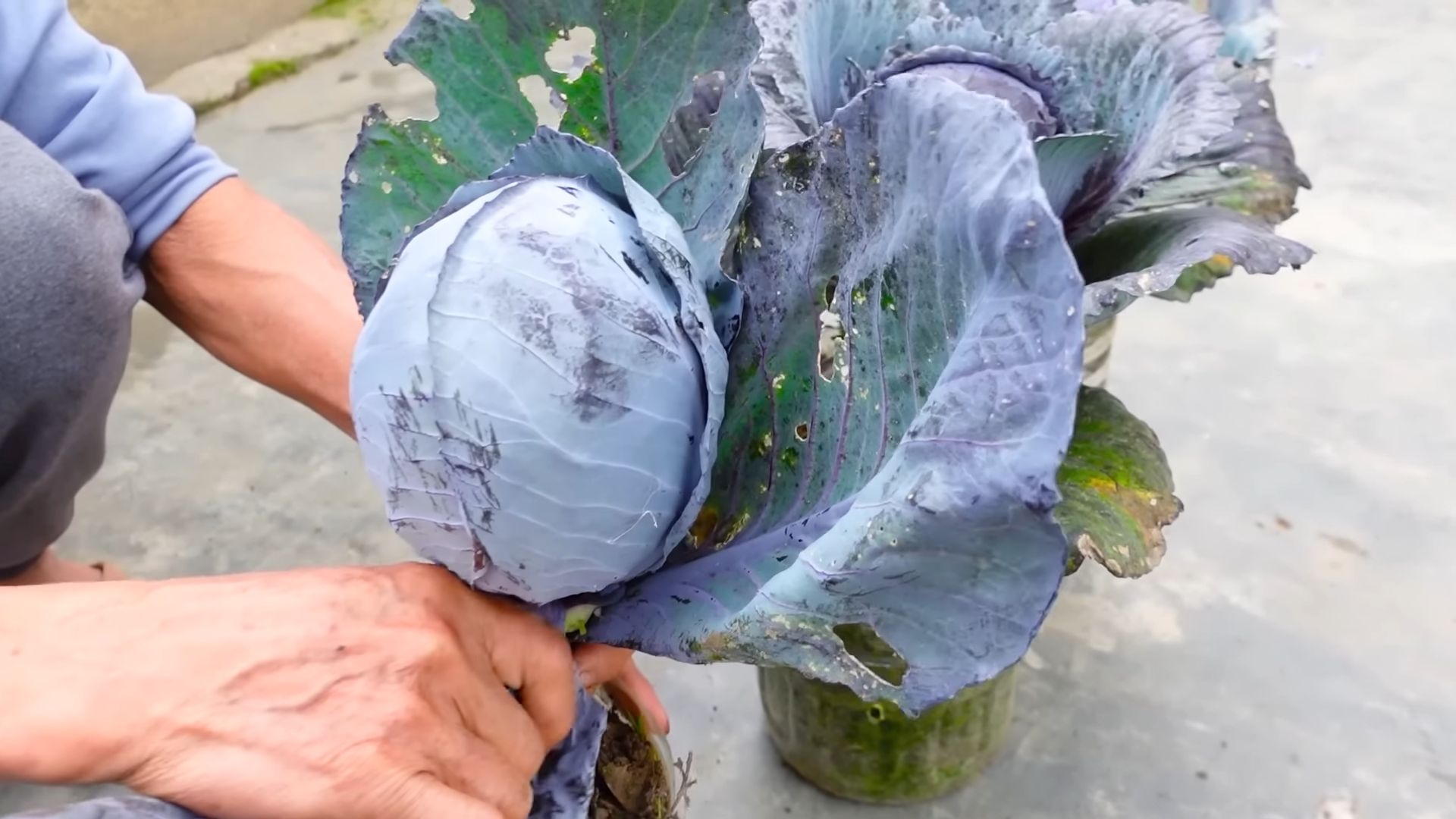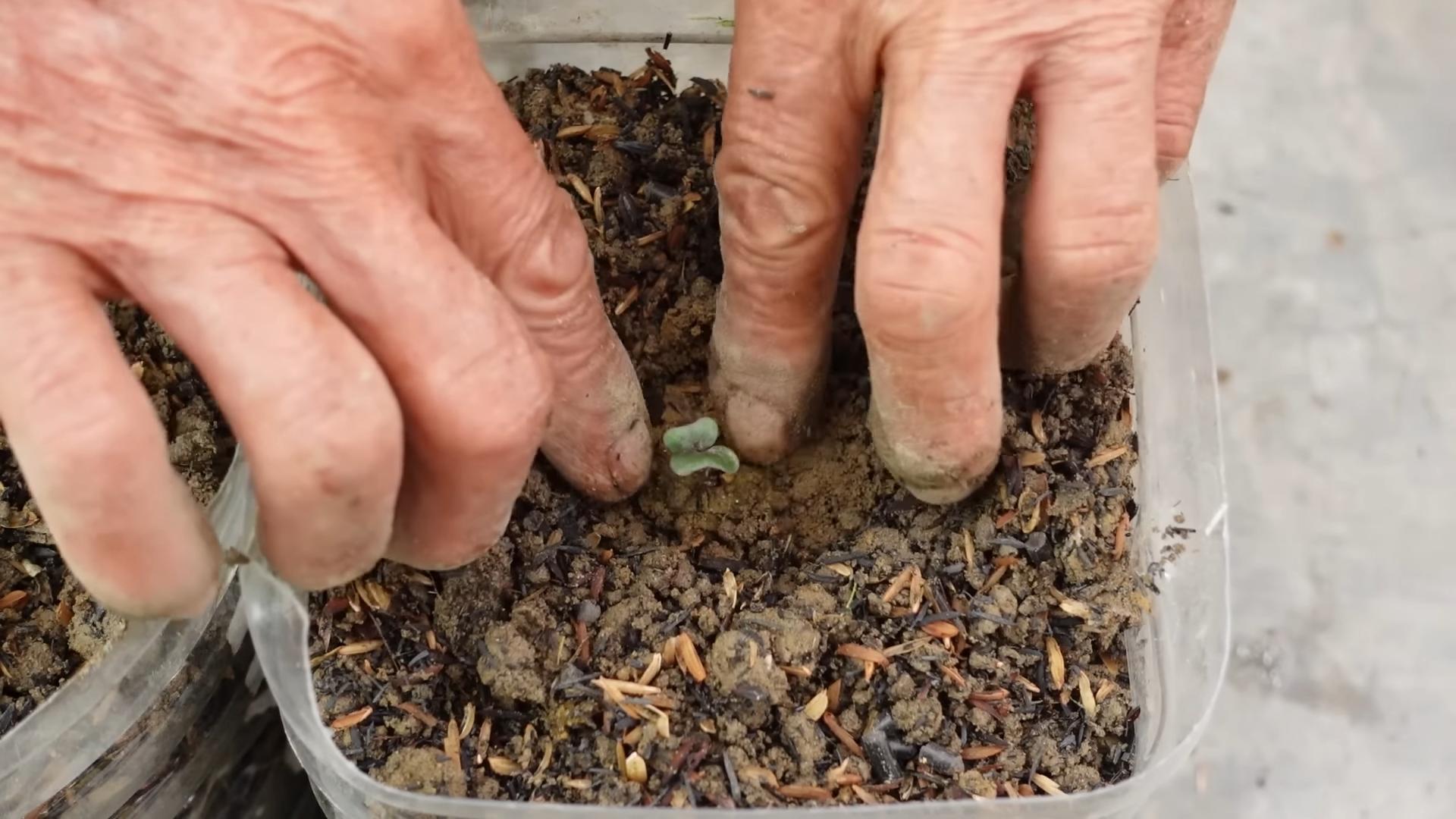Grow Purple Cabbage at Home? Absolutely! Imagine serving up a vibrant, jewel-toned slaw or adding a pop of color to your stir-fries with cabbage you nurtured yourself. It’s easier than you think, and this DIY guide will show you exactly how to do it, even if you’re a beginner gardener like I once was!
Cabbage, in general, has a rich history, dating back to ancient times and holding a significant place in various cultures. From being a staple food in Europe to symbolizing prosperity in some Asian traditions, this humble vegetable has nourished and sustained communities for centuries. Now, the purple variety brings an extra dose of visual appeal and nutritional benefits to your table.
But why should you bother learning to grow purple cabbage at home? Well, store-bought produce can be expensive and sometimes lacks the freshness and flavor of homegrown vegetables. Plus, there’s nothing quite like the satisfaction of harvesting something you’ve cultivated with your own hands. This DIY trick not only saves you money but also allows you to control the quality of your food, ensuring it’s free from harmful pesticides and packed with nutrients. I’m excited to share my tips and tricks to help you succeed!

Growing Gorgeous Purple Cabbage at Home: A DIY Guide
Hey there, fellow gardening enthusiasts! Ever dreamt of adding a vibrant splash of color to your garden and your dinner plate? Well, look no further than the majestic purple cabbage! It’s not only beautiful but also packed with nutrients and surprisingly easy to grow at home. I’m going to walk you through every step, from seed to harvest, so you can enjoy your own homegrown purple cabbage.
Choosing Your Variety and Starting Seeds
First things first, let’s talk about choosing the right variety. There are several purple cabbage varieties available, each with slightly different characteristics. Some popular choices include:
* ‘Red Acre’: A classic, reliable variety with a deep purple color and a slightly flattened head. It matures relatively quickly.
* ‘Ruby Ball’: Known for its round, compact heads and excellent flavor. It’s a good choice for smaller gardens.
* ‘Red Express’: As the name suggests, this variety is a fast grower, perfect if you’re impatient like me! It has a slightly milder flavor.
* ‘Langedijker Dauer’: A Dutch heirloom variety, known for its excellent storage capabilities. If you want to enjoy your cabbage throughout the winter, this is a great option.
Once you’ve chosen your variety, it’s time to start the seeds. You can either direct sow them into the garden, but I prefer to start them indoors for a head start, especially if you live in an area with a shorter growing season.
Here’s how I do it:
1. Gather your supplies: You’ll need seed starting trays or small pots, seed starting mix (a light, well-draining mix is crucial), purple cabbage seeds, a spray bottle, and a warm, sunny location or a grow light.
2. Fill the trays/pots: Fill each cell or pot with seed starting mix, leaving about half an inch of space at the top.
3. Sow the seeds: Place 2-3 seeds in each cell or pot, about ¼ inch deep. Gently cover them with more seed starting mix.
4. Water gently: Use a spray bottle to moisten the soil. Avoid overwatering, as this can lead to damping off, a fungal disease that can kill seedlings.
5. Provide warmth and light: Place the trays/pots in a warm location (around 70-75°F) with plenty of sunlight or under a grow light. If using a grow light, keep it a few inches above the seedlings.
6. Keep the soil moist: Check the soil daily and water gently when the top inch feels dry.
7. Thin the seedlings: Once the seedlings have their first true leaves (the second set of leaves), thin them to one seedling per cell or pot. Choose the strongest, healthiest-looking seedling and snip off the others at the soil line.
Preparing the Garden Bed
While your seedlings are growing, it’s time to prepare the garden bed. Purple cabbage thrives in well-drained soil that is rich in organic matter.
Here’s what I do to get my garden bed ready:
1. Choose a sunny location: Purple cabbage needs at least 6 hours of sunlight per day.
2. Test the soil: A soil test will tell you the pH level and nutrient content of your soil. Purple cabbage prefers a slightly acidic soil with a pH between 6.0 and 7.0. You can purchase a soil testing kit at most garden centers or send a sample to your local agricultural extension office.
3. Amend the soil: Based on the soil test results, amend the soil as needed. If the soil is too acidic, add lime to raise the pH. If it’s too alkaline, add sulfur to lower the pH. Incorporate plenty of compost or well-rotted manure to improve drainage and add nutrients. I usually add a generous amount of compost, as it’s a great all-around soil amendment.
4. Till or dig the soil: Loosen the soil to a depth of at least 12 inches. This will allow the roots to grow easily. Remove any rocks, weeds, or debris.
5. Create raised beds (optional): Raised beds can improve drainage and warm up the soil faster in the spring. They’re especially helpful if you have heavy clay soil.
Transplanting the Seedlings
Once your seedlings are about 4-6 inches tall and have several sets of true leaves, they’re ready to be transplanted into the garden. This usually takes about 4-6 weeks after sowing the seeds.
Here’s how I transplant my purple cabbage seedlings:
1. Harden off the seedlings: Before transplanting, you need to harden off the seedlings to acclimate them to outdoor conditions. This involves gradually exposing them to sunlight, wind, and cooler temperatures over a period of 7-10 days. Start by placing them outdoors for a few hours each day, gradually increasing the amount of time they spend outside.
2. Choose a cloudy day: Transplanting on a cloudy day will help prevent the seedlings from getting stressed by the sun.
3. Dig holes: Dig holes that are slightly larger than the root balls of the seedlings. Space the holes about 18-24 inches apart.
4. Remove the seedlings from the trays/pots: Gently remove the seedlings from their containers, being careful not to damage the roots. If the roots are tightly bound, gently loosen them with your fingers.
5. Plant the seedlings: Place the seedlings in the holes and backfill with soil. Make sure the top of the root ball is level with the soil surface.
6. Water thoroughly: Water the seedlings thoroughly after planting.
7. Mulch around the plants: Mulch around the plants with straw, wood chips, or shredded leaves. This will help retain moisture, suppress weeds, and regulate soil temperature.
Caring for Your Purple Cabbage
Now that your purple cabbage is planted, it’s time to provide the care it needs to thrive.
Here’s what I do to keep my purple cabbage happy and healthy:
1. Water regularly: Purple cabbage needs consistent moisture, especially during hot, dry weather. Water deeply whenever the top inch of soil feels dry. Aim for about 1-1.5 inches of water per week.
2. Fertilize: Fertilize your purple cabbage every 2-3 weeks with a balanced fertilizer. Follow the instructions on the fertilizer package. I like to use an organic fertilizer, such as fish emulsion or compost tea.
3. Weed regularly: Keep the garden bed free of weeds, as they can compete with the cabbage for nutrients and water. Hand-pull weeds or use a hoe to cultivate the soil.
4. Protect from pests: Purple cabbage is susceptible to several pests, including cabbage worms, aphids, and flea beetles.
* Cabbage worms: These green caterpillars can devour the leaves of your cabbage plants. I usually handpick them off the plants or use Bacillus thuringiensis (Bt), a natural insecticide that is effective against cabbage worms.
* Aphids: These tiny insects suck the sap from the leaves, causing them to curl and distort. I control aphids by spraying them with a strong stream of water or using insecticidal soap.
* Flea beetles: These small, jumping beetles can create tiny holes in the leaves. I control flea beetles by using row covers or applying diatomaceous earth around the plants.
5. Protect from diseases: Purple cabbage can also be affected by several diseases, including black rot and clubroot.
* Black rot: This bacterial disease causes yellowing and browning of the leaves, eventually leading to the death of the plant. To prevent black rot, use disease-free seeds, practice crop rotation, and avoid overhead watering.
* Clubroot: This fungal disease causes swollen, distorted roots, which can stunt the growth of the plant. To prevent clubroot, raise the soil pH to 7.0 or higher, practice crop rotation, and use resistant varieties.
Harvesting Your Purple Cabbage
Purple cabbage is typically ready to harvest about 70-100 days after transplanting, depending on the variety. The heads should be firm and compact.
Here’s how I harvest my purple cabbage:
1. Check for firmness: Gently squeeze the head of the cabbage. If it feels firm and solid, it’s ready to harvest.
2. Cut the head: Use a sharp knife to cut the head from the plant, leaving a few outer leaves attached.
3. Store the cabbage: Store the cabbage in the refrigerator for up to several weeks. Wrap it in plastic wrap or place it in a plastic bag to prevent it from drying out.
Enjoying Your Homegrown Purple Cabbage
Now that you’ve harvested your beautiful purple cabbage, it’s time to enjoy it! Purple cabbage can be eaten raw in salads, coleslaw, or sandwiches. It can also be cooked in a variety of ways, such as steaming, stir-frying

Conclusion
So, there you have it! Growing your own vibrant, healthy purple cabbage at home is not only achievable but also incredibly rewarding. Forget those expensive, often lackluster heads at the grocery store. With a little patience and the right approach, you can cultivate beautiful, nutrient-rich purple cabbage right in your backyard or even in containers on your balcony.
This DIY method offers a multitude of benefits. You’ll have complete control over the growing process, ensuring your cabbage is free from harmful pesticides and herbicides. Plus, the taste of homegrown produce is simply unparalleled. The crispness, the slight sweetness, and the intense color of freshly harvested purple cabbage are a testament to your hard work and dedication.
But the advantages don’t stop there. Growing your own food is a sustainable practice that reduces your carbon footprint and connects you to the natural world. It’s a fantastic way to teach children about where their food comes from and to instill in them a love for gardening. And let’s not forget the sheer satisfaction of watching a tiny seed transform into a magnificent head of purple cabbage!
Consider these variations to personalize your purple cabbage growing experience:
* Succession Planting: Plant seeds every few weeks to ensure a continuous harvest throughout the growing season.
* Companion Planting: Plant your cabbage alongside herbs like rosemary and thyme to deter pests naturally. Marigolds are also excellent companions for cabbage.
* Container Gardening: If you’re short on space, grow your purple cabbage in large containers. Choose a well-draining potting mix and ensure the containers receive at least six hours of sunlight per day.
* Different Varieties: Experiment with different varieties of purple cabbage, such as ‘Red Acre’ or ‘Ruby Perfection,’ to discover your favorite flavor and texture.
* Fermenting: Once you have a good harvest, consider fermenting your purple cabbage into sauerkraut or kimchi for a delicious and probiotic-rich treat.
Don’t be intimidated by the prospect of growing your own purple cabbage. It’s a relatively straightforward process, and the rewards are well worth the effort. We encourage you to give this DIY trick a try. Start small, learn as you go, and don’t be afraid to experiment.
We’re confident that you’ll be amazed by the results. And once you’ve harvested your first head of homegrown purple cabbage, we’d love to hear about your experience. Share your photos, tips, and stories in the comments below. Let’s create a community of purple cabbage enthusiasts! Happy gardening!
Frequently Asked Questions (FAQ)
1. What is the best time of year to plant purple cabbage?
The best time to plant purple cabbage depends on your climate. In general, purple cabbage is a cool-season crop, meaning it thrives in temperatures between 60°F and 70°F (15°C and 21°C).
* For spring crops: Start seeds indoors 6-8 weeks before the last expected frost. Transplant seedlings outdoors 2-3 weeks before the last frost.
* For fall crops: Start seeds indoors in mid-summer. Transplant seedlings outdoors in late summer or early fall, allowing enough time for the cabbage to mature before the first hard frost.
2. How much sunlight does purple cabbage need?
Purple cabbage requires at least six hours of direct sunlight per day. Choose a planting location that receives ample sunlight throughout the day. If you’re growing cabbage in containers, make sure to place them in a sunny spot. Insufficient sunlight can result in smaller heads and poor color development.
3. What type of soil is best for growing purple cabbage?
Purple cabbage prefers well-draining, fertile soil that is rich in organic matter. The ideal soil pH is between 6.0 and 7.0. Before planting, amend the soil with compost or well-rotted manure to improve drainage and fertility. You can also add a slow-release fertilizer to provide essential nutrients throughout the growing season.
4. How often should I water my purple cabbage plants?
Purple cabbage needs consistent moisture to thrive. Water deeply and regularly, especially during dry periods. Aim to keep the soil consistently moist but not waterlogged. Mulching around the plants can help retain moisture and suppress weeds. Check the soil moisture regularly by sticking your finger about an inch into the soil. If it feels dry, it’s time to water.
5. What are some common pests and diseases that affect purple cabbage?
Purple cabbage can be susceptible to various pests and diseases, including cabbage worms, aphids, flea beetles, and clubroot.
* Cabbage worms: These caterpillars can devour cabbage leaves. Handpick them off the plants or use Bacillus thuringiensis (Bt), a natural insecticide.
* Aphids: These small insects suck sap from the leaves. Spray them with a strong stream of water or use insecticidal soap.
* Flea beetles: These tiny beetles create small holes in the leaves. Cover the plants with row covers to prevent infestation.
* Clubroot: This soilborne disease causes swollen roots and stunted growth. Prevent clubroot by practicing crop rotation and maintaining a soil pH above 7.0.
6. How do I know when my purple cabbage is ready to harvest?
Purple cabbage is typically ready to harvest when the head is firm and dense. The size of the head will vary depending on the variety, but a general guideline is to harvest when the head is about 6-8 inches in diameter. To harvest, use a sharp knife to cut the head from the stem, leaving a few outer leaves intact.
7. Can I grow purple cabbage in containers?
Yes, you can successfully grow purple cabbage in containers. Choose a large container that is at least 12 inches in diameter and 12 inches deep. Use a well-draining potting mix and ensure the container has drainage holes. Place the container in a sunny location and water regularly.
8. How do I store purple cabbage after harvesting?
Purple cabbage can be stored in the refrigerator for several weeks. Wrap the head tightly in plastic wrap or place it in a plastic bag. Store it in the crisper drawer. You can also shred or chop the cabbage and freeze it for later use.
9. Is purple cabbage more nutritious than green cabbage?
Purple cabbage is indeed highly nutritious and often considered more so than green cabbage due to its higher concentration of anthocyanins, the pigments that give it its vibrant color. Anthocyanins are powerful antioxidants that have been linked to various health benefits, including reducing the risk of heart disease and certain cancers. Both types of cabbage are excellent sources of vitamins, minerals, and fiber, but purple cabbage offers an extra boost of antioxidants.
10. Can I save seeds from my purple cabbage to plant next year?
Saving seeds from purple cabbage can be a bit tricky, as cabbage is a biennial plant, meaning it takes two years to produce seeds. You would need to overwinter the cabbage plant and allow it to flower and produce seeds in the second year. However, cabbage is also cross-pollinated, so the seeds you collect may not produce true-to-type purple cabbage. For best results, it’s generally recommended to purchase fresh seeds each year.





Leave a Comment